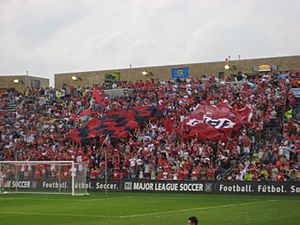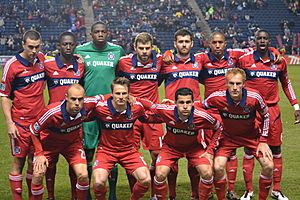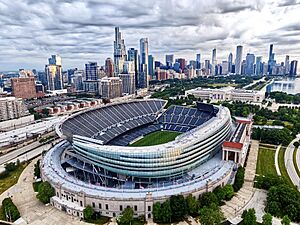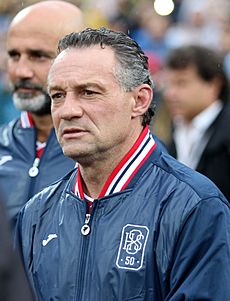Chicago Fire FC facts for kids
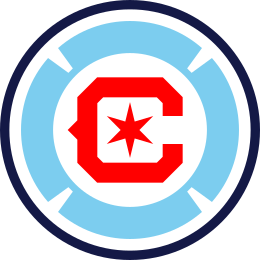 |
|||
| Nickname(s) | The Fire The Men in Red |
||
|---|---|---|---|
| Founded | October 8, 1997 | ||
| Stadium | Soldier Field Chicago, Illinois |
||
| Stadium capacity |
61,500 | ||
| Owner | Joe Mansueto | ||
| Sporting director | Gregg Berhalter | ||
| Head coach | Gregg Berhalter | ||
| League | Major League Soccer | ||
| 2024 | Eastern Conference: 15th Overall: 28th Playoffs: Did not qualify |
||
|
|
|||
The Chicago Fire Football Club is a professional soccer team from Chicago, Illinois. They play in Major League Soccer (MLS) as part of the Eastern Conference. The Fire's home games are held at Soldier Field, which they share with the Chicago Bears, an American football team.
The team was started on October 8, 1997, and is named after the famous Great Chicago Fire of 1871. This date was the 126th anniversary of that historic event. The Chicago Fire was one of the first new teams to join the MLS in 1998. In their very first season, they won both the MLS Cup and the Lamar Hunt U.S. Open Cup. Winning both in one year is called achieving the "double." They also won the U.S. Open Cup in 2000, 2003, and 2006. In 2003, they won the MLS Supporters' Shield for having the best regular season record. Even though they have sometimes finished low in the league, the Chicago Fire FC is worth a lot of money, over $500 million.
The club also has programs to help young players grow, like the Chicago Fire Development Academy. They also run the Chicago Fire Foundation, which is their charity that helps the community.
Contents
Team History
How the Fire Started
The Chicago Fire Football Club began as the Chicago Fire Soccer Club on October 8, 1997. The team's name honors the Great Chicago Fire of 1871. Joe Mansueto became the owner of the club in 2019.
The Fire played at Soldier Field from 1997 to 2006. Then, from 2006 to 2019, they played at SeatGeek Stadium in Bridgeview, Illinois. In 2019, the team moved back to Soldier Field for the 2020 MLS season. The Fire has won the U.S. Open Cup four times: in 1998, 2000, 2003, and 2006.
Many famous players have played for the Fire. These include U.S. players like Chris Armas and Brian McBride. The team has also brought in talented international players such as Bastian Schweinsteiger and Cuauhtémoc Blanco.
Before the Fire, Chicago had another soccer team called the Chicago Sting. They played in the North American Soccer League from 1975 to 1984. The Sting won the Soccer Bowl twice, in 1981 and 1984.
Early Success (1997–2000)
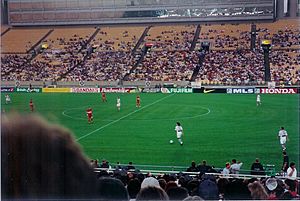
The Fire was founded in 1997. The team quickly brought in players from different countries, like Piotr Nowak from Poland and Jorge Campos from Mexico. American players like Zach Thornton and Chris Armas were also very important.
Under their first coach, Bob Bradley, the team had an amazing first year. They won the "double" in 1998. This means they won both the MLS Cup Final against D.C. United and the U.S. Open Cup against the Columbus Crew.
The team continued to do well. They won the 2000 U.S. Open Cup and reached the MLS Cup final in 2000, where they lost to the Kansas City Wizards. Famous international players like Hristo Stoitchkov joined the team, and young American players like DaMarcus Beasley became stars. The Fire quickly became one of the best teams in the league.
Moving Around (2002–2004)
In 2002, Soldier Field was being renovated, so the Fire moved their home games to Naperville, Illinois. That same year, coach Bob Bradley left the team. Dave Sarachan became the new head coach.
In 2003, Chicago had a great season. They won the MLS Supporters' Shield and the U.S. Open Cup. They also made it to the league final. The team moved back to the newly renovated Soldier Field in the middle of the 2003 season.
After 2003, the team's performances started to slow down. In 2004, they missed the league playoffs for the first time ever.
New Home and Changes (2005–2007)
The 2005 season started with a big change: the popular club president, Peter Wilt, was fired. This upset many fans and players. He was replaced by John Guppy.
In 2006, the Fire moved into their new stadium in Bridgeview, Illinois, called Toyota Park (now SeatGeek Stadium). In their first season there, they won the U.S. Open Cup.
Fans really wanted another league title. In 2007, the Fire signed Mexican star player Cuauhtémoc Blanco. After a strong start, the team struggled, and coach Dave Sarachan was fired. Juan Carlos Osorio became the new head coach.
New Ownership (2007–2009)
More changes happened in 2007 when Andell Holdings bought the Chicago Fire. Since then, the team has not won a major trophy.
Under coach Osorio, and with players like Blanco, the Fire played very well and made it to the playoffs. However, Osorio left to coach the New York Red Bulls. In 2008, former Fire star Frank Klopas became the Technical Director, and Denis Hamlett was named manager.
The team signed Chicago native Brian McBride in 2008. They beat the New England Revolution in the playoffs but lost to the Columbus Crew in the Eastern Conference Final. In 2009, the team finished second in the Eastern Conference. They hosted a playoff semi-final but lost to Real Salt Lake in a penalty shootout. After this, manager Denis Hamlett was fired.
A Period of Change (2010–2012)
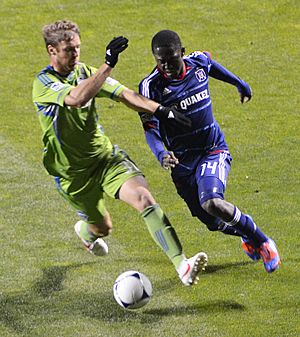
In 2010, Carlos de los Cobos became the new head coach. Many key players left the team. Despite bringing in new players like Nery Castillo and Freddie Ljungberg, the Fire did not make the playoffs. Famous players Brian McBride and C.J. Brown retired at the end of the season.
The 2011 season also started poorly. After nine games without a win, Carlos de los Cobos was fired. Frank Klopas became the interim head coach. With new players like Pável Pardo, the Fire improved and reached the U.S. Open Cup Final, but they lost. They just missed the playoffs. Klopas was then made the permanent coach.
In 2012, the Fire had a much better season. They signed players like Chris Rolfe and Arne Friedrich. The team finished fourth in the Eastern Conference. They made the playoffs for the first time since 2009 but lost their first game to the Houston Dynamo.
Missing the Playoffs (2013–2015)
The team made more changes in 2013 to improve. They traded for Mike Magee, who became a key player. Magee later won the MLS MVP Award in 2013, the first Fire player to do so. The Fire reached the semi-finals of the 2013 Lamar Hunt U.S. Open Cup but lost. They narrowly missed the playoffs.
On October 31, 2013, Frank Yallop was named the new head coach and director of soccer. He brought in new coaching staff, including former Fire player C. J. Brown. Yallop also changed the team roster, bringing in younger players.
In 2014, the Fire reached the semi-finals of the 2014 Lamar Hunt U.S. Open Cup again but lost badly. The season ended with the Fire having a record of 6 wins, 18 losses, and 10 ties, setting a record for most ties in an MLS season.
The 2015 season started with new hope and three new "Designated Players" (star players who can be paid more) like David Accam. However, the team struggled and had their worst start ever. They reached the U.S. Open Cup semi-finals for the third year in a row but lost again. Coach Frank Yallop was fired in September 2015. The team finished the 2015 season with 8 wins, 20 losses, and 6 ties, and they did not win any away games.
Final Years in Bridgeview (2016–2019)
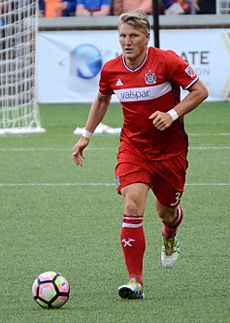
In November 2015, Veljko Paunovic, who had coached the Serbian U-20 team to a World Cup win, was named the new head coach. In March 2017, famous German player Bastian Schweinsteiger joined the Chicago Fire from Manchester United.
In 2018, Joe Mansueto bought a part of the club. By September 2019, Mansueto became the full owner of the team.
Return to Soldier Field (2020–Present)
After the 2019 season, the Chicago Fire team made big changes. They planned to move back to downtown Chicago, change their team structure, and get a new look.
On October 8, 2019, the Fire announced they would return to Soldier Field for the 2020 MLS season. On the same day, Bastian Schweinsteiger announced his retirement. Other players also left the team.
On November 21, 2019, the club revealed its new brand. They changed their name to Chicago Fire FC and updated their colors to red, blue, and gold. They also introduced a new logo. This new logo was not very popular with fans at first. The club later unveiled a new crest in 2021, which became official in 2022. This new logo was designed by Matthew Wolff.
The Fire continued to make player changes. They signed Argentinian players Ignacio Aliseda and Gaston Gimenez, and French striker Robert Beric. In February 2022, the Fire signed Xherdan Shaqiri for $7.5 million, which was the most expensive signing in the club's history.
Team Colors and Badge
The Chicago Fire's main colors are red, flag blue, deep blue, and white. Over the years, they have also used navy blue, sky blue, gold, and black. The original logo, used from 1997 to 2019, looked like the Cross of Saint Florian, a symbol often used by fire departments. It had a stylized "C" for Chicago and six points around the center, representing the stars on the Flag of Chicago. One of these stars remembers the Great Chicago Fire of 1871.
The first Fire jerseys looked like a Chicago firefighter's coat, with wide horizontal stripes. The home jersey was red and white. The away jerseys changed over the years, from white and black to all-white or all-blue. Sometimes, they had yellow third jerseys to honor the old Chicago Sting team. From 2014 to 2016, the club wore third jerseys based on the Flag of Chicago.
The club and its fans often use symbols of Chicago to show their city pride. The six-pointed Chicago stars and the light blue color of the city flag are common.
On November 21, 2019, the club changed its name to Chicago Fire Football Club (Chicago Fire FC) and introduced a new logo. This new logo featured a shape with mirrored triangles called the "Fire Crown." The main colors were dark blue, red, and gold. Fans did not like the new logo much at first. The club later released a new logo in 2021, which became their official crest in 2022.
Stadium

From 2006 to 2019, the Chicago Fire played their home games at SeatGeek Stadium in Bridgeview, Illinois. This stadium was built just for soccer and cost about $100 million. It was first called Toyota Park.
When the Fire first started, they played at Soldier Field in Chicago. This stadium is also home to the Chicago Bears NFL team. While Soldier Field was being renovated, the Fire played at Cardinal Stadium in Naperville, Illinois. They returned to Soldier Field in 2003 and stayed there until 2005.
In 2019, the Chicago Fire made a deal to leave SeatGeek Stadium and move back to Soldier Field starting in 2020. This move was finalized in September 2019.
On June 3, 2025, the owner of Chicago Fire FC, Joe Mansueto, announced plans for a new, privately funded soccer stadium. This stadium will be located along the Chicago River and will be part of a new area called The 78. This area will include restaurants, shops, offices, homes, and green spaces.
Home Stadiums Over Time
- Soldier Field; Chicago (1998–2001, 2003–2005, 2020–present)
- Cardinal Stadium; Naperville, Illinois (2002–2003)
- SeatGeek Stadium; Bridgeview, Illinois (2006–2019)
Club Culture
Supporters
The Chicago Fire has a strong fan base. The main supporters' group is called Section 8 Chicago. They sit behind the north goal at Toyota Park (now SeatGeek Stadium). This area is known as Section 8, named after the section number at Soldier Field.
Section 8 Chicago is a group run by volunteers. They organize chants and displays to support the team. Fans at SeatGeek Stadium often create large tifo displays, which are big banners or pictures held up by the crowd.
Other fan groups include The Arsonists, Fire Ultras 98, and Ultras Red-Side.
Mascot
The official mascot of the Chicago Fire is Sparky. Sparky is a Dalmatian dog who wears the team's jersey or firefighter gear.
Rivalries
The Fire has rivalries with several other MLS teams. Older fans might say their main rival is FC Dallas or Los Angeles Galaxy because of intense playoff games in the early years.
After the Fire moved to the Eastern Conference, they developed rivalries with D.C. United and New England Revolution. The Fire and Revolution have played each other in the MLS Cup Playoffs 8 times between 2000 and 2009.
Newer rivals include the Columbus Crew, who used to be the closest MLS team to Chicago. Also, Atlanta United FC has become a rival due to fan disagreements. In 2023, St. Louis City SC joined the league, and a rivalry has naturally grown between the two teams because Chicago and St. Louis are historic rival cities.
Broadcasting
Since 2020, WGN-TV has shown Chicago Fire games on regional television. Most MLS games are now available on Apple TV through their rights deal that started in 2023. This means Chicago Fire games are mostly broadcast on Apple TV.
Spanish-language radio station WRTO has broadcast Chicago Fire matches since 2017. In April 2023, the Fire announced a deal with Cumulus Media to broadcast games in English on WLS 890 AM or its website.
Players
Current Roster
|
|
Players on Loan
|
Ring of Fire Hall of Fame
The "Ring of Fire" was created in 2003 to honor people who have made the Chicago Fire club successful. Only current "Ring of Fire" members can choose new people to join, and only one person can be chosen each year. Their names and jersey numbers are shown at SeatGeek Stadium.
In 2008, members voted to honor two fans who had passed away, but the club owner did not allow it. These fans were later honored on the "Wall of Honor," a special recognition for Fire fans.
On May 9, 2012, C.J. Brown, a former Fire player, was officially added to the Ring of Fire. On October 3, 2015, Ante Razov, the club's all-time leading scorer, became the eighth person to join. Most recently, on February 10, 2024, former goalkeeper Zach Thornton was inducted. His ceremony will be held on April 27 at Soldier Field.
 10 Piotr Nowak (inducted 2003)
10 Piotr Nowak (inducted 2003) 41 Frank Klopas (inducted 2004)
41 Frank Klopas (inducted 2004) 5 Luboš Kubík (inducted 2005)
5 Luboš Kubík (inducted 2005) Former general manager and club president Peter Wilt (inducted 2006)
Former general manager and club president Peter Wilt (inducted 2006) Former head coach Bob Bradley (inducted 2007)
Former head coach Bob Bradley (inducted 2007) 14 Chris Armas (inducted 2009)
14 Chris Armas (inducted 2009) 2 C.J. Brown (inducted 2012)
2 C.J. Brown (inducted 2012) 9 Ante Razov (inducted 2015)
9 Ante Razov (inducted 2015) 18 Zach Thornton (inducted 2024)
18 Zach Thornton (inducted 2024)
Team Staff
Head Coaches
| Name | Nationality | Time as Coach |
|---|---|---|
| Bob Bradley | October 30, 1997 – October 5, 2002 | |
| Dave Sarachan | November 4, 2002 – June 20, 2007 | |
| Denis Hamlett (interim) | June 20, 2007 – June 30, 2007 | |
| Juan Carlos Osorio | July 1, 2007 – December 10, 2007 | |
| Denis Hamlett | January 11, 2008 – November 24, 2009 | |
| Carlos de los Cobos | January 1, 2010 – May 30, 2011 | |
| Frank Klopas (interim) | May 30, 2011 – November 3, 2011 | |
| Frank Klopas | November 3, 2011 – October 30, 2013 | |
| Frank Yallop | October 31, 2013 – September 20, 2015 | |
| Brian Bliss (interim) | September 20, 2015 – November 24, 2015 | |
| Veljko Paunović | November 24, 2015 – November 13, 2019 | |
| Raphaël Wicky | December 27, 2019 – September 30, 2021 | |
| Frank Klopas (interim) | September 30, 2021 – November 7, 2021 | |
| Ezra Hendrickson | November 24, 2021 – May 8, 2023 | |
| Frank Klopas (interim) | May 8, 2023 – December 5, 2023 | |
| Frank Klopas | December 5, 2023 – October 19, 2024 | |
| Gregg Berhalter | October 20, 2024 – Present |
Team Achievements
| National Titles | |||
|---|---|---|---|
| Competitions | Wins | Seasons Won | |
| MLS Cup | 1 | 1998 | |
| Supporters' Shield | 1 | 2003 | |
| U.S. Open Cup | 4 | 1998, 2000, 2003, 2006 | |
- Other Awards
- MLS Team Fair Play Award: 2009
Minor Awards
- MLS Wooden Spoon: 2015, 2016 (This award is given to the team with the worst record in the league.)
Team Records
Most Games Played
| # | Name | Years Played | Total Games |
|---|---|---|---|
| 1 | 1998–2010 | 350 | |
| 2 | 2003–2014 | 317 | |
| 3 | 2005–2009; 2010–2014 |
256 | |
| 4 | 1998–2007 | 254 | |
| 5 | 1998–2006 | 253 |
Top Goal Scorers
| # | Name | Years Played | Total Goals |
|---|---|---|---|
| 1 | 1998–2000 2001–2004 |
94 | |
| 2 | 2017–2019 | 55 | |
| 3 | 2005–2009 2012–2014 |
55 | |
| 4 | 1998–2002 | 39 | |
| 5 | 2015–2017 | 38 |
Season-by-Season Performance (Recent Years)
This table shows how the Fire has performed in the last five seasons.
| Season | League Play | Rank | Playoffs | USOC | Other Competitions | Average Attendance |
Top Scorer(s) | |||||||||||||
|---|---|---|---|---|---|---|---|---|---|---|---|---|---|---|---|---|---|---|---|---|
| Division | League | Games Played | Wins | Losses | Ties | Goals For | Goals Against | Goal Diff. | Points | Points Per Game | Conference | Overall | Name(s) | Goals | ||||||
| 2019 | 1 | MLS | 34 | 10 | 12 | 12 | 55 | 47 | +8 | 42 | 1.24 | 8th | 17th | Did Not Qualify | Round 4 | Leagues Cup | Quarterfinals | 12,324 | 13 | |
| 2020 | MLS | 23 | 5 | 10 | 8 | 33 | 39 | −6 | 23 | 1.00 | 11th | 22nd | Not Held | MLS is Back Tournament | Group Stage | 0 | 12 | |||
| 2021 | MLS | 34 | 9 | 18 | 7 | 36 | 54 | −18 | 34 | 1.00 | 12th | 22nd | Not Held | Did Not Qualify | 10,703 | 8 | ||||
| 2022 | MLS | 34 | 10 | 15 | 9 | 39 | 48 | −9 | 39 | 1.15 | 12th | 24th | Round 3 | 15,848 | 8 | |||||
| 2023 | MLS | 34 | 10 | 14 | 10 | 39 | 51 | −12 | 40 | 1.18 | 13th | 24th | Quarterfinals | Leagues Cup | Round of 32 | 18,170 | 6 | |||
1. Avg. attendance includes statistics from league matches only.
2. Top goalscorer(s) includes all goals scored in League, MLS Cup Playoffs, U.S. Open Cup, MLS is Back Tournament, CONCACAF Champions League, FIFA Club World Cup, and other competitive continental matches.
Team Awards
| Year | Team MVP | Golden Boot | Defender of the Year | |
|---|---|---|---|---|
| Winner | Goals | |||
| 1998 | 10 | |||
| 1999 | 14 | |||
| 2000 | 18 | |||
| 2001 | 10 | |||
| 2002 | 14 | |||
| 2003 | 14 | |||
| 2004 | 11 | |||
| 2005 | 8 | |||
| 2006 | 9 | |||
| 2007 | 7 | |||
| 2008 | 9 | |||
| 2009 | 7 | |||
| 2010 | 7 | |||
| 2011 | 12 | |||
| 2012 | 8 | |||
| 2013 | 15 | |||
| 2014 | 8 | |||
| 2015 | 10 | |||
| 2016 | 9 | |||
| 2017 | 24 | |||
| 2018 | 15 | |||
| 2019 | 13 | |||
| 2020 | 12 | |||
| 2021 | 8* | |||
| 2022 | 8 | |||
| 2023 | 6 | |||
| 2024 | 10 | |||
Golden Boot is the team leader in goals (regular season games only). * Indicates a season where two players tied for the Golden Boot award.
See also
 In Spanish: Chicago Fire para niños
In Spanish: Chicago Fire para niños


